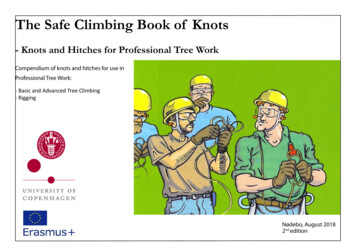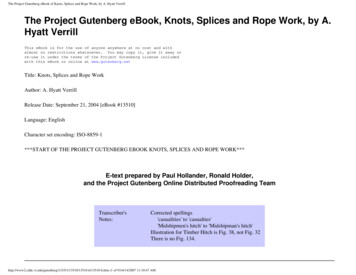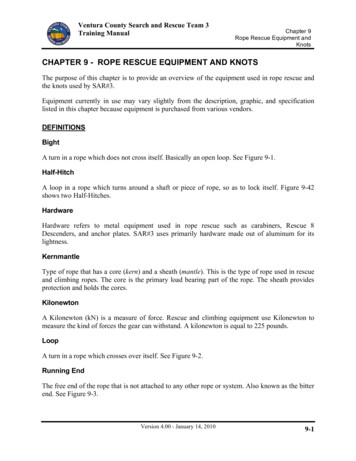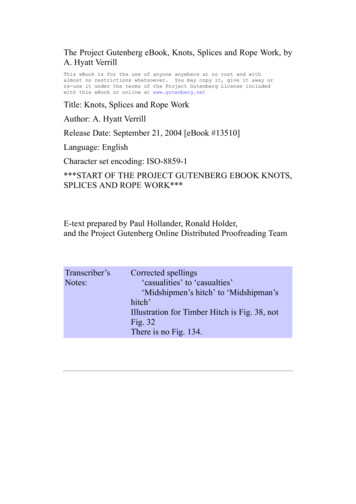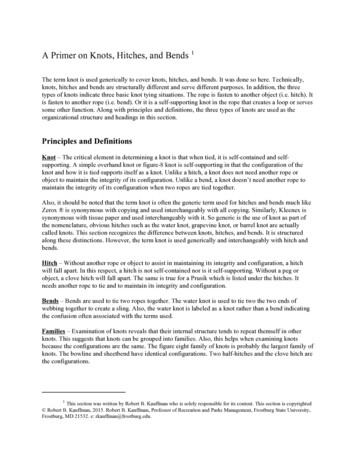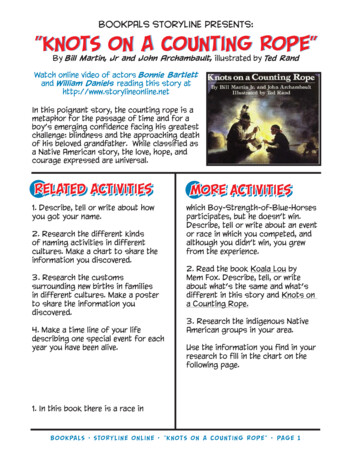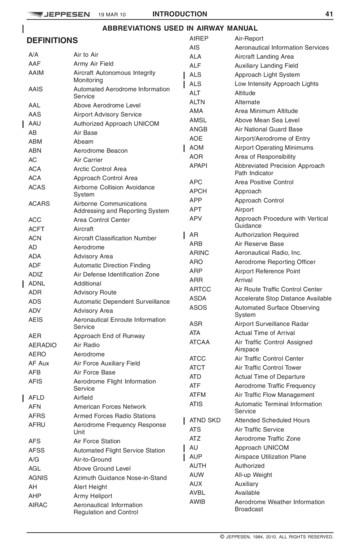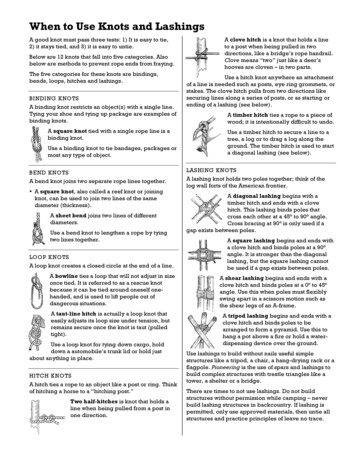
Transcription
When to Use Knots and LashingsA good knot must pass three tests: 1) It is easy to tie,2) it stays tied, and 3) it is easy to untie.Below are 12 knots that fall into five categories. Alsobelow are methods to prevent rope ends from fraying.The five categories for these knots are bindings,bends, loops, hitches and lashings.BINDI NG K NOTSA binding knot restricts an object(s) with a single line.Tying your shoe and tying up package are examples ofbinding knots.A square knot tied with a single rope line is abinding knot.Use a binding knot to tie bandages, packages ormost any type of object.BEND KNOTSA bend knot joins two separate rope lines together. A square knot, also called a reef knot or joiningknot, can be used to join two lines of the samediameter (thickness).A sheet bend joins two lines of differentdiameters.Use a bend knot to lengthen a rope by tyingtwo lines together.LOOP K NOTSA loop knot creates a closed circle at the end of a line.A bowline ties a loop that will not adjust in sizeonce tied. It is referred to as a rescue knotbecause it can be tied around oneself onehanded, and is used to lift people out ofdangerous situations.A taut-line hitch is actually a loop knot thateasily adjusts its loop size under tension, butremains secure once the knot is taut (pulledtight).Use a loop knot for tying down cargo, holddown a automobile’s trunk lid or hold justabout anything in place.HITCH K NOTSA hitch ties a rope to an object like a post or ring. Thinkof hitching a horse to a “hitching post.”Two half-hitches is knot that holds aline when being pulled from a post inone direction.A clove hitch is a knot that holds a lineto a post when being pulled in twodirections, like a bridge’s rope handrail.Clove means “two” just like a deer’shooves are cloven – in two parts.Use a hitch knot anywhere an attachmentof a line is needed such as posts, eye ring grommets, orstakes. The clove hitch pulls from two directions likesecuring lines along a series of posts, or as starting orending of a lashing (see below).A timber hitch ties a rope to a piece ofwood; it is intentionally difficult to undo.Use a timber hitch to secure a line to atree, a log or to drag a log along theground. The timber hitch is used to starta diagonal lashing (see below).LASHI NG KNOTSA lashing knot holds two poles together; think of thelog wall forts of the American frontier.A diagonal lashing begins with atimber hitch and ends with a clovehitch. This lashing binds poles thatcross each other at a 45 to 90 angle.Cross bracing at 90 is only used if agap exists between poles.A square lashing begins and ends witha clove hitch and binds poles at a 90 angle. It is stronger than the diagonallashing, but the square lashing cannotbe used if a gap exists between poles.A shear lashing begins and ends with aclove hitch and binds poles at a 0 to 45 angle. Use this when poles must flexiblyswing apart in a scissors motion such asthe shear legs of an A-frame.A tripod lashing begins and ends with aclove hitch and binds poles to bearranged to form a pyramid. Use this tohang a pot above a fire or hold a waterdispensing device over the ground.Use lashings to build without nails useful simplestructures like a tripod, a chair, a hang-drying rack or aflagpole. Pioneering is the use of spars and lashings tobuild complex structures with trestle triangles like atower, a shelter or a bridge.There are times to not use lashings. Do not buildstructures without permission while camping – neverbuild lashing structures in backcountry. If lashing ispermitted, only use approved materials, then untie allstructures and practice principles of leave no trace.
WHIPPINGWhipping intends to stop a rope end from unraveling. Tie a rope end with a simple overhand knot andwrap it with duct tape for a temporary fix.A whipping knot uses twine to bindnatural-fiber rope.Heat fusing with a candle or match meltsthe end of artificial-fiber ropes made ofplastic or nylon.References: http://www.ropeworks.biz The Boy Scout Handbook
Stop a Rope Line from UnravelingNatural-fiber rope.Artificial-fiber rope.Common Whipping KnotHeat Fusing1.1.2.3.4.2.5.6.See: http://en.wikipedia.org/wiki/Common whippingSee: The Boy Scout Handbook, pg. 34Bind an ObjectUsing a single line.Square KnotKnot detail view1.2.3.Right over left 4.5.6. left over right.
Join Two LinesTie a Loop at the End of a LineLines of same diameter. Lines of differentdiameters.A fixed size loop.An adjustable size loop.BowlineTaut-line HitchSquare KnotSheet 4.4.4.5.5.5.Underneathsame line,but on top ofsecond line.6.5.6.6.See: ide
Tie a Line to a Post or RingHolds a line in one direction.Holds a line in two directions.Two Half HitchesClove HitchKnot does not adjustOption 1:Bottom-up, left to right terminating line.1.1.Option 2:Bottom-up, right to left terminating line.1.Option 3:Looping line over theend of a post.1.2.2.2.Form erminalend6.6.6.See: 219.html
Tie a Line toa Piece of WoodLash Two Polesat a 45 to 90 AngleLash Two Polesat a 90 AngleKnot is intentionallydifficult to undo.Use at 90 only if gapexists between poles.Stronger thandiagonal lashing.Timber HitchDiagonal LashingSquare Lashing1.1.5.1.3 angewrappingdirection3.3.3 tightwraps4.ready forwrappingchange5.2 tightwraps7.3.3 tightwraps2 tightwraps8.4.clovehitchready forwrappingchangedirection6.See: hitch
Lash Two Polesat a 0 to 45 AngleLash ThreePoles TogetherForm a flexible joint to allowa scissors-leg motion.Form a flexible joint to allowa pyramid-leg bending.Shear LashingTripod Lashing1.1.clovehitch3 tightwrapsbetweenpole 1andpole 2clovehitch2.3.6.6.2.7.3.8.3 tightwrapsbetweenpole 2andpole 33 tightwrapsbetweenpoles4.7.4.4 windingwrapsaroundpoles5.4 5.clovehitch10.changewrappingdirectionSee: itch
BINDING KNOTS A binding knot restricts an object(s) with a single line. Tying your shoe and tying up package are examples of binding knots. A square knot tied with a single rope line is a binding knot. Use a binding knot to tie bandages, packages or most any type of object. BEND KNOTS A bend knot
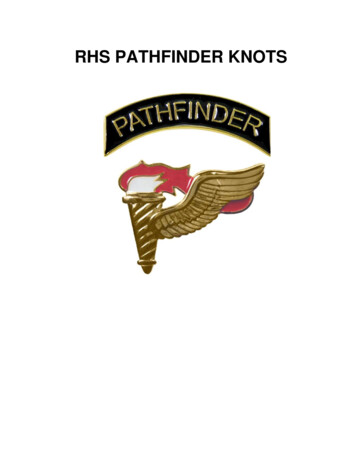
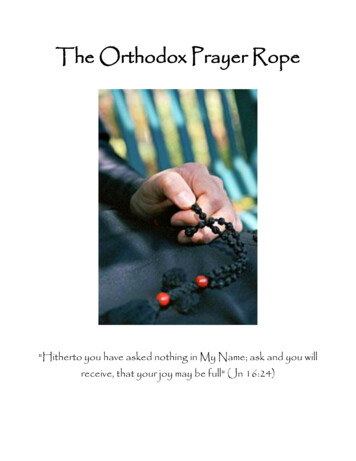
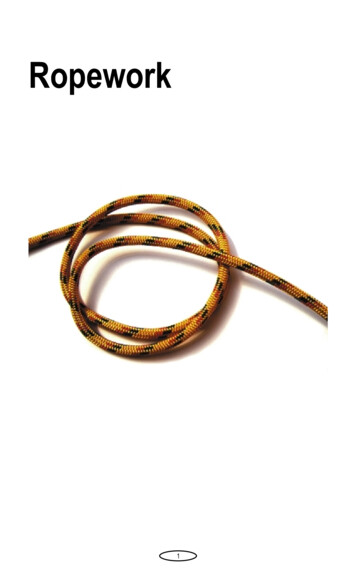
![BCA160 Macrame [2015] - NDSU](/img/19/bca160.jpg)
